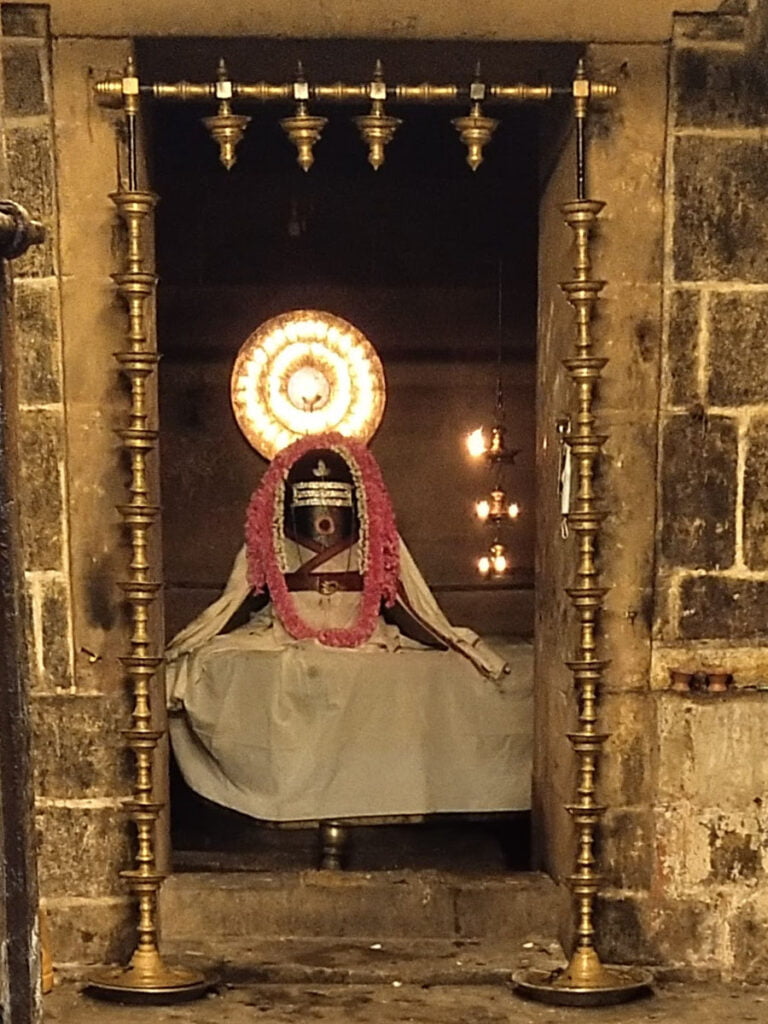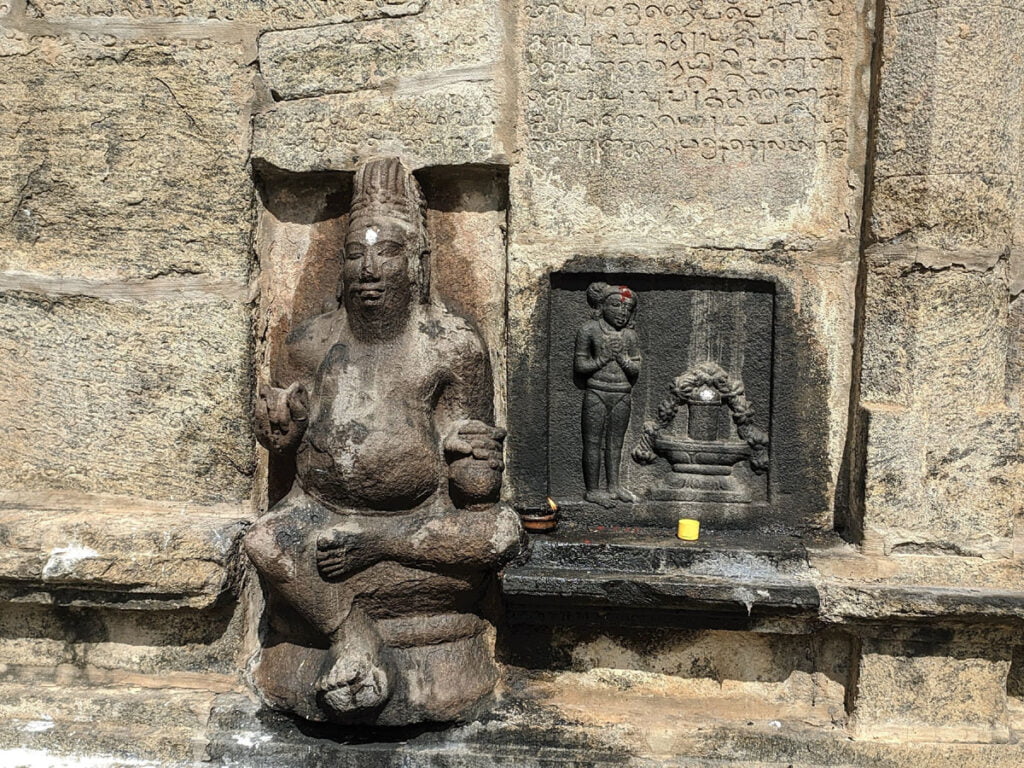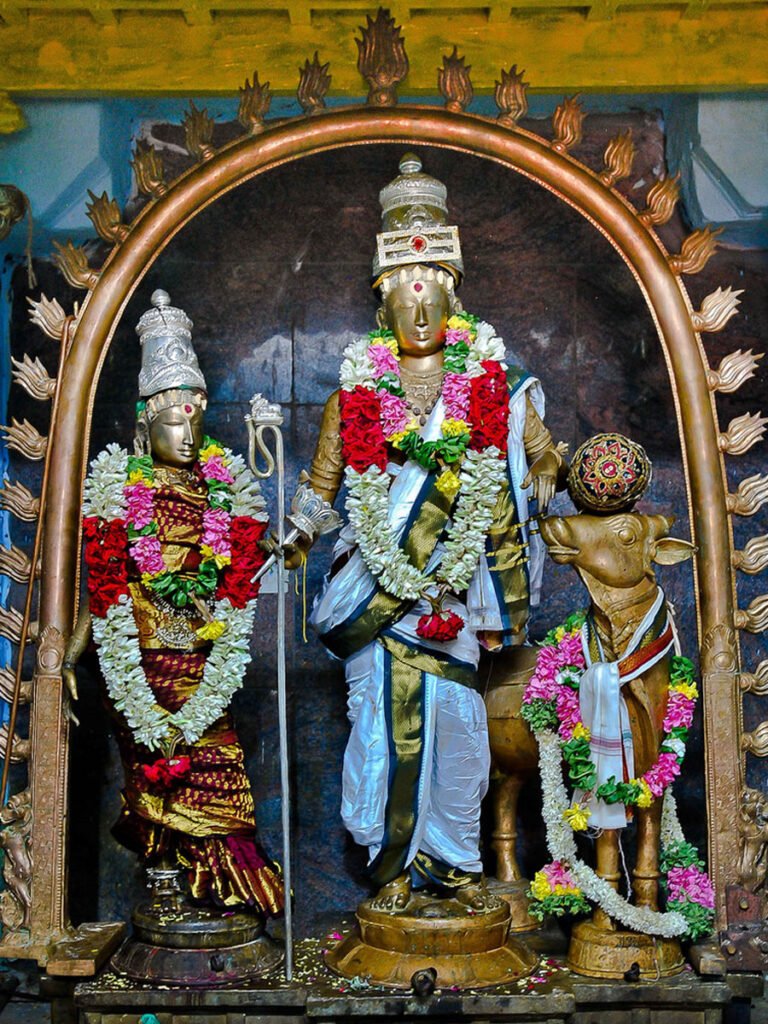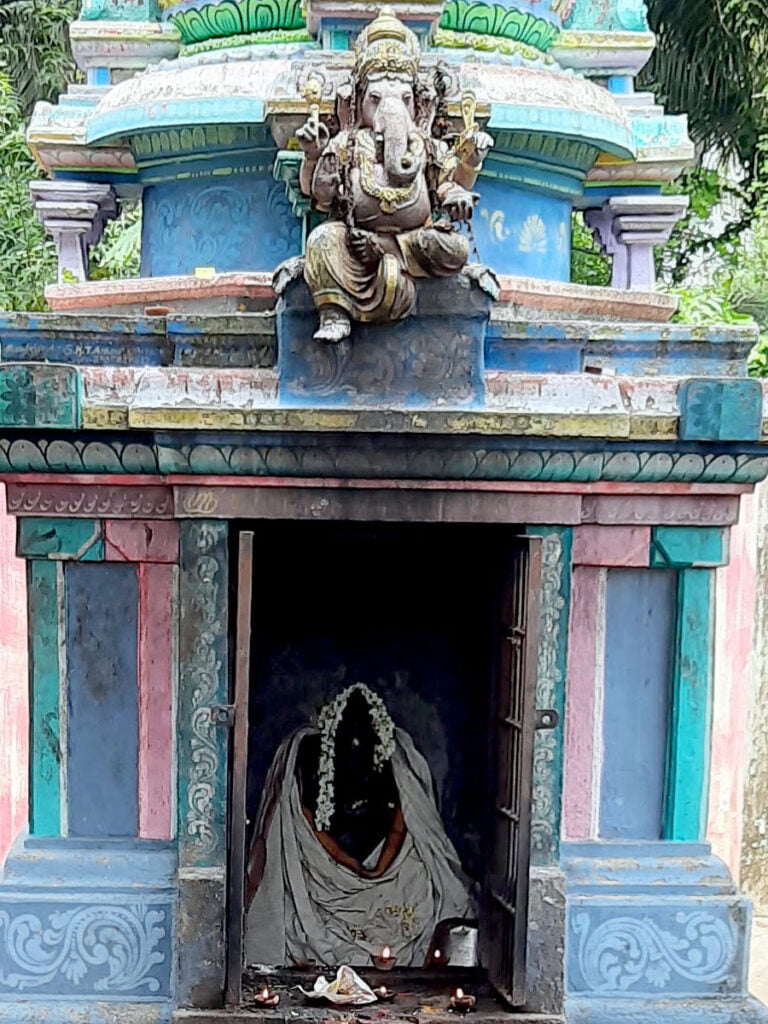Thirumanancheri Temple | Kalyanasundareswarar Temple
Thirumanancheri Temple, also known as Sri Kalyanasundareswarar Temple, is an ancient Hindu temple dedicated to Lord Shiva. It is located in the Thirumanancheri village in the Thanjavur district of Tamil Nadu, India. The temple is one of the 275 Paadal Petra Sthalams, Shiva Sthalams glorified in the early medieval Tevaram poems by Tamil Saivite Nayanars Tirugnanasambandar and Tirunavukkarasar.

Contents
- 1 Thirumanancheri Temple History:
- 2 Legend of Thirumanancheri Temple:
- 3 Significance of Thirumanancheri Temple:
- 4 Myths and beliefs of Thirumanancheri Temple:
- 5 Thirumanancheri Temple Timing and Rituals:
- 6 Festivals of Thirumanancheri Temple:
- 7 Places to visit near Thirumanancheri Temple Kumbakonam:
- 8 FAQ:
- 8.0.1 What is Thirumanancheri Temple?
- 8.0.2 Why is Thirumanancheri Temple called the “Marriage Temple”?
- 8.0.3 What are the important features of Thirumanancheri Temple?
- 8.0.4 What are the rituals and festivals celebrated at Thirumanancheri Temple?
- 8.0.5 How to get to Thirumanancheri Temple?
- 8.0.6 Things to do near Thirumanancheri Temple
- 8.0.7 When was Thirumanancheri Temple built?
- 8.0.8 Who is the presiding deity of Thirumanancheri Temple?
- 9 How to reach Thirumanancheri Temple, Kumbakonam:
- 10 Google Maps:
Thirumanancheri Temple History:
The temple is believed to have been built by Agastya Rishi, a sage who is said to have come to the region from the Himalayas. The temple is also associated with the story of the marriage of Shiva and Parvati. According to the legend, Parvati wanted to marry Shiva, but he was not interested. Parvati then went into meditation to pray for his love. After many years of meditation, Parvati’s prayers were answered and she was able to marry Shiva.
The temple is a popular pilgrimage destination for Hindus. The temple is also known for its annual Karthigai Deepam festival, which is celebrated in the month of Karthigai (November-December). During the festival, a large lamp is lit in the temple courtyard. The lamp is said to be visible from a distance of 30 kilometers.
The temple complex is spread over a large area. The main shrine is dedicated to Lord Shiva, who is known as Kalyanasundareswarar. The shrine is located in the center of the temple complex. The temple also houses shrines dedicated to Parvati, Vishnu, and other Hindu deities.
The temple is a beautiful example of Dravidian architecture. The temple walls are decorated with intricate carvings of Hindu gods and goddesses. The temple is also home to a number of sculptures and paintings.
Read More>> Treta Yuga Vaikom Mahadeva Temple
Legend of Thirumanancheri Temple:
The Divine Union:
- This legend speaks of Parvati’s unwavering devotion to Lord Shiva. Longing for his hand in marriage, she embarked on intense meditation, seeking his divine favor. Pleased by her dedication, Shiva granted her wish, and their celestial union unfolded in a place that came to be known as Thirumanancheri, meaning “village of the divine marriage.”
- Here, Shiva, embodied as Kalyanasundareswarar (meaning “beautiful bridegroom”), united with Parvati, revered as Kokilambal (meaning “nightingale”). Their ethereal wedding ceremony continues to resonate within the temple walls, making it a sacred haven for those seeking blessings for their own marital bliss.
Restoring Balance:
- Another legend delves into the cosmic event of Shiva and Parvati’s grand wedding on Mount Kailash. The sheer magnitude of the celebration caused the celestial abode to tilt off balance. To restore equilibrium, Shiva dispatched Agastya Rishi southward, entrusting him with the task of establishing a sacred lingam (representation of Shiva) on Earth.
- Guided by divine intervention, Agastya Rishi arrived at the very spot where the Thirumanancheri Temple now stands. He installed the lingam and commenced fervent prayers, imbuing the location with Shiva’s divine essence. Over time, devotees constructed the temple, transforming it into a beacon of spiritual energy and a testament to the cosmic connection between the heavens and Earth.
These are just two of the many legends that surround the Thirumanancheri Temple. Each narrative adds a layer of enchantment to the temple’s aura, drawing devotees from far and wide to seek not only blessings but also a glimpse into the timeless connection between the divine and the mortal.
Read More>> Ramaswamy Temple Kumbakonam

Significance of Thirumanancheri Temple:
1. Sacred Marriage Site:
- The temple’s name itself reveals its association with marriage. “Thirumanan” means “marriage” and “cheri” means “village,” making Thirumanancheri the “village of marriages.”
- Legend has it that Lord Shiva and Goddess Parvati tied the knot here, infusing the temple with divine blessings for marital harmony and success.
2. Bestowing Marriages:
- Devotees believe that praying at the temple removes obstacles hindering their marriage prospects and expedites finding suitable partners.
- This belief transcends social and physical limitations. Even those facing challenges due to disabilities or delayed marriages find solace and hope in the temple’s divine grace.
3. Architectural Marvel:
- The temple boasts a Dravidian architectural style, characterized by intricate carvings, towering gopurams (gateways), and a serene ambience.
- The sanctum sanctorum houses the majestic murtis (idols) of Lord Shiva as Kalyanasundareswarar (the beautiful bridegroom) and Goddess Parvati as Parvati Amman.
4. Historical Importance:
- The temple finds mention in the Tevaram hymns, composed by the 7th-century Saivite saints, highlighting its historical and spiritual significance for centuries.
- It is one of the 275 Paadal Petra Sthalams, revered Shiva temples glorified in the hymns, further solidifying its place in the tapestry of Tamil Nadu’s rich cultural heritage.
5. Beyond Marriages:
- While the temple’s primary association lies with marriages, devotees also seek blessings for overall well-being, prosperity, and success in various aspects of life.
Read More>> Sarangapani Temple Kumbakonam

Myths and beliefs of Thirumanancheri Temple:
One of the myths associated with Thirumanancheri Temple is that it was built by the sage Agastya. The sage is said to have brought the image of Vishnu from Mount Kailash to Thirumanancheri. He is also said to have performed penance at the temple, which is why it is also known as Agastya Kshetram.
Another myth associated with Thirumanancheri Temple is that it was built by the god Vishnu himself. The god is said to have appeared to the sage Agastya and instructed him to build a temple at this spot.
The temple is believed to be a powerful place of worship. It is said that those who pray at the temple will be blessed with prosperity, good health, and happiness.
Here are some of the beliefs associated with Thirumanancheri Temple:
- The temple is believed to be a place of healing. It is said that those who pray at the temple for healing will be cured of their ailments.
- The temple is believed to be a place of protection. It is said that those who pray at the temple will be protected from harm.
- The temple is believed to be a place of enlightenment. It is said that those who pray at the temple will attain enlightenment.
Read More>> Adi Kumbeswara Temple Kumbakonam: Amazing Temple with 1000 Columns
Thirumanancheri Temple Timing and Rituals:
Temple timings: The temple is open for darshan from 6:00 AM to 1:30 PM and from 3:30 PM to 8:30 PM, every day. The Ambal Abhishekam takes place between 7:30 AM to 8:30 AM.
Daily rituals: The temple performs six daily poojas, namely:
- Ushakkalam (morning ablutions)
- Uchikalam (afternoon ablutions)
- Sayaratchai (evening ablutions)
- Kalai Santhi (evening prayer)
- Artha Jamam (midnight ablutions)
- Irandam Kalam (morning ablutions)
Weekly rituals: Every Tuesday and Friday, the temple performs Sahasranamam and Lalitha Thiruchathi Archana. These rituals are performed for the welfare of the world.
Special rituals: The temple also performs special rituals on certain days of the year. These include:
- Milk payasam to Mangala Rahu for Putra bhagyam (progeny) on every Amavasai day.
- Abhishekam on the first day of every Tamil month, during pradosham.
- Abhishekam and Umamaheshwara homam on Sankatahara chathurthi and days of Poosa nakshathram.
Marriage rituals: The Thirumanancheri Temple is a popular destination for couples seeking early marriage. The temple offers a special Kalyana Prathanai pooja that is believed to help couples achieve their goal of marriage. The pooja is performed by a priest and includes prayers, offerings, and rituals.
Read More>> Arunachalam Giri Pradakshina: Sacred 8 Lingams of Tiruvannamalai

Festivals of Thirumanancheri Temple:
The temple celebrates a number of festivals throughout the year, including:
- Chithirai Wedding Festival: This three-day festival is celebrated in the Tamil month of Chithirai (April-May). The festival commemorates the wedding of Lord Shiva and Parvati. On the first day, the deities are taken in a procession around the temple. On the second day, the wedding ceremony is performed. On the third day, the deities are taken in a procession to the seashore.
- Aadi Pooram Festival: This festival is celebrated in the Tamil month of Aadi (July-August). The festival is dedicated to Lord Shiva. On the day of the festival, a grand procession is held in which the deities are taken around the temple. The procession is accompanied by music, dance, and fireworks.
- Margazhi Tiruvadhirai Festival: This festival is celebrated in the Tamil month of Margazhi (December-January). The festival is dedicated to Lord Shiva. On the day of the festival, the deities are taken in a procession around the temple. The procession is accompanied by music, dance, and fireworks.
In addition to these major festivals, the temple also celebrates a number of other festivals throughout the year, including:
- Navaratri Festival: This nine-day festival is celebrated in the Hindu month of Ashvin (October-November). The festival is dedicated to the goddess Durga.
- Vijayadashami Festival: This festival is celebrated on the tenth day of Navaratri. The festival commemorates the victory of good over evil.
- Kartikai Deepam Festival: This festival is celebrated on the full moon day of the Tamil month of Karthikai (November-December). The festival is dedicated to the goddess Lakshmi.
- Maha Shivaratri Festival: This festival is celebrated on the fourteenth night of the dark fortnight of the Hindu month of Phalguna (February-March). The festival is dedicated to Lord Shiva.
Read More>> Subramanya Swamy Temple at Tiruttani

Places to visit near Thirumanancheri Temple Kumbakonam:
- Kumbakonam Temples:
- Kumbakonam is renowned for its numerous temples. Some of the notable ones include Sarangapani Temple, Kumbeswarar Temple, and Ramaswamy Temple. Each temple has its unique architecture and cultural significance.
- Mahamaham Tank:
- This large temple tank is located in the heart of Kumbakonam and is considered one of the holiest tanks in South India. It is believed that taking a dip in the Mahamaham tank during the Mahamaham festival cleanses one of sins.
- Swamimalai Murugan Temple:
- Swamimalai, located near Kumbakonam, is famous for the Swamimalai Murugan Temple. It is one of the six abodes of Lord Murugan and is situated atop a small hill.
- Airavatesvara Temple, Darasuram:
- A UNESCO World Heritage Site, the Airavatesvara Temple in Darasuram is known for its stunning architecture and intricate carvings. It is dedicated to Lord Shiva and is a must-visit for history and architecture enthusiasts.
- Gangaikonda Cholapuram:
- Another UNESCO World Heritage Site, Gangaikonda Cholapuram is an ancient temple complex built by the Chola dynasty. The Brihadeshwara Temple here is an architectural marvel.
- Saraswathi Mahal Library:
- Located in Tanjore, about an hour’s drive from Kumbakonam, Saraswathi Mahal Library is one of the oldest libraries in Asia. It houses a vast collection of ancient manuscripts, palm-leaf manuscripts, and rare books.
- Nageswaran Temple:
- This temple is known for its architectural brilliance and is dedicated to Lord Shiva. It is located in Kumbakonam and is worth a visit for its historical and religious significance.
- Thirunallar Saniswaran Temple:
- Thirunallar, situated a bit farther away, is famous for the Shani (Saturn) temple. It is believed that worshiping Lord Shani here can alleviate the adverse effects of Saturn in one’s horoscope.
FAQ:
What is Thirumanancheri Temple?
Thirumanancheri Temple is a Hindu temple dedicated to Lord Shiva, located in the town of Thirumanancheri, Tamil Nadu, India. It is one of the most important pilgrimage sites in Tamil Nadu, and is especially revered by those seeking marriage blessings.
Why is Thirumanancheri Temple called the “Marriage Temple”?
Thirumanancheri Temple is called the “Marriage Temple” because it is believed to be the site of the marriage of Lord Shiva and Parvati. According to legend, Parvati was cursed by a sage to become a cow. She wandered the earth in this form for many years, until she finally came to Thirumanancheri. There, she met Lord Shiva, who agreed to marry her. The wedding was held at Thirumanancheri Temple, and it is said that the seven seas merged into one to celebrate the occasion.
What are the important features of Thirumanancheri Temple?
Thirumanancheri Temple is a large and complex temple complex, with many important features. The main temple is dedicated to Lord Shiva, and it is located in the center of the complex. The temple is built in Dravidian style, and it features a tall, ornate gopuram (gateway).
The temple also houses a number of other shrines, including shrines dedicated to Parvati, Vishnu, and other Hindu deities. There is also a large tank (pond) located in the temple complex. This tank is said to have healing properties, and it is a popular spot for pilgrims to bathe.
What are the rituals and festivals celebrated at Thirumanancheri Temple?
Thirumanancheri Temple celebrates a number of important rituals and festivals throughout the year. The most important festival is the Shivaratri festival, which is celebrated in February or March. On this day, the temple is decorated with flowers and lights, and there are special rituals and prayers.
Other important festivals celebrated at Thirumanancheri Temple include the Navaratri festival, the Karthigai Deepam festival, and the Maha Shivratri festival.
How to get to Thirumanancheri Temple?
Thirumanancheri Temple is located about 35 kilometers from the town of Kumbakonam. It is easily accessible by car, bus, or train.
By car, take the Kumbakonam-Thanjavur highway and turn left at the sign for Thirumanancheri. The temple is located about 5 kilometers from the highway.
By bus, take a bus from Kumbakonam to Thirumanancheri. Buses depart frequently from the Kumbakonam bus station.
By train, take a train to Kumbakonam. Once in Kumbakonam, take a bus or taxi to Thirumanancheri.
Things to do near Thirumanancheri Temple
In addition to visiting Thirumanancheri Temple, there are a number of other things to do near the temple. These include:
- Visiting the Thirumanancheri tank, which is said to have healing properties.
- Visiting the Thirumanancheri market, which is a good place to buy souvenirs and local produce.
- Taking a walk through the Thirumanancheri countryside, which is beautiful and peaceful.
When was Thirumanancheri Temple built?
The exact date of the construction of Thirumanancheri Temple is unknown. However, it is believed to have been built in the 9th or 10th century CE. The temple is mentioned in the hymns of the 7th century CE Tamil poet-saint Appar.
Who is the presiding deity of Thirumanancheri Temple?
The presiding deity of Thirumanancheri Temple is Lord Shiva, who is worshipped as Kalyana Sundareswarar. The goddess Parvati is worshipped as his consort, who is known as Gowri or Soundarya.
How to reach Thirumanancheri Temple, Kumbakonam:
By Road:
- From Kumbakonam:
- Thirumanancheri Temple is approximately 6-7 kilometers east of Kumbakonam.
- You can hire a taxi, auto-rickshaw, or use your own vehicle to reach the temple.
- If you’re driving, you can use navigation apps like Google Maps for real-time directions.
By Train:
- Nearest Railway Station: Kumbakonam Railway Station
- Kumbakonam has a railway station, and you can reach it by train.
- From Kumbakonam Railway Station, you can hire a taxi or an auto-rickshaw to reach Thirumanancheri Temple.
By Air:
- Nearest Airport: Tiruchirapalli International Airport (TRZ)
- The nearest airport to Kumbakonam is Tiruchirapalli International Airport.
- From the airport, you can hire a taxi or use other local transportation to reach Kumbakonam.
- Once in Kumbakonam, follow the road directions mentioned above.
Local Transportation:
- Taxi/Auto-rickshaw:
- Taxis and auto-rickshaws are readily available in Kumbakonam.
- You can hire one to take you directly to Thirumanancheri Temple.
Tips:
- It’s advisable to check with the locals or use a reliable navigation app for the most accurate and up-to-date directions.
- If you’re not familiar with the area, it’s recommended to ask for directions from locals or seek assistance from the transportation services.
